|
Blizzard of '78
 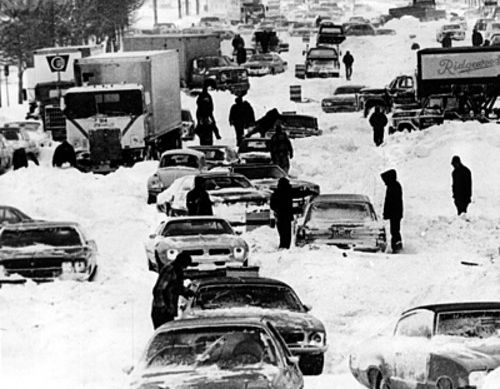
One of the most powerful winter storms on record paralyzed the central and eastern United States in late January 1978. We will take a look back in time and look at how this Great Blizzard developed and share some memories from longtime residents of the area.
The Great Blizzard
The massive storm began as two small but distinct storms. A strong low pressure system and arctic airmass was dropping southward out of Canada into the northern plains on the 24th. At the same time, another low pressure system in association with a disturbance embedded with the sub tropical jet stream across the southern United States was taking shape over eastern Texas.
 The phasing of these two systems was the key to the subsequent intensification and extent of this great storm. It all began as the tremendous Arctic stream jet streak surged nearly due south while the associated Arctic cold front blasted through the northern plains late on the 24th. Concurrently, a strong upper level sub tropical jet streak was present across Arizona. These two jet steaks initially split by a huge upper level ridge of high pressure along the west coast combined on the 25th with low pressure deepening as it moved from east Texas into Georgia by evening (surface | 500mb). Meanwhile, across the north, the Arctic front barreled east across the upper midwest and into the western great lakes. The phasing of these two systems was the key to the subsequent intensification and extent of this great storm. It all began as the tremendous Arctic stream jet streak surged nearly due south while the associated Arctic cold front blasted through the northern plains late on the 24th. Concurrently, a strong upper level sub tropical jet streak was present across Arizona. These two jet steaks initially split by a huge upper level ridge of high pressure along the west coast combined on the 25th with low pressure deepening as it moved from east Texas into Georgia by evening (surface | 500mb). Meanwhile, across the north, the Arctic front barreled east across the upper midwest and into the western great lakes.
As this process unfolded overnight on the 25th, the surface low deepened explosively 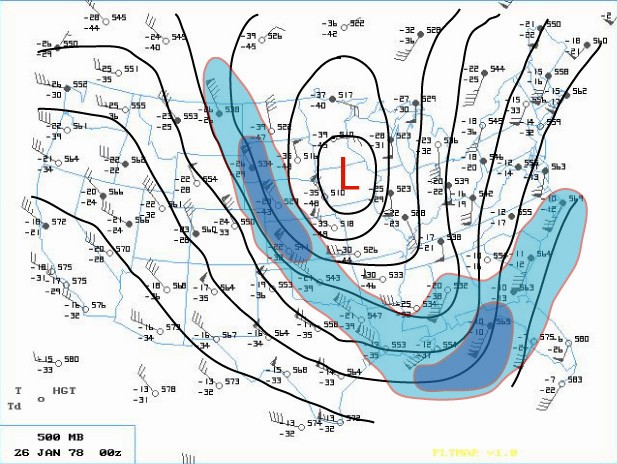 over Alabama and Georgia as the subtropical and arctic jet stream began to phase with a jet streak of 150 knots noted and of which contributed to the tremendous intensification of the surface low as it "bombed" northward into west Virginia . At the same time, snow began breaking out across Illinois, Indiana and Michigan with a mix of rain and snow changing to all rain over northwest Ohio due to warm air surging northward ahead of the rapidly intensifing storm. All-time record low barometric pressures were set along its path with the low's central pressure falling an incredible 40 millibars in 24 hours, falling to an astounding 956mb in Mount Clemens Michgan at 8am EST on January 26, 1978.! over Alabama and Georgia as the subtropical and arctic jet stream began to phase with a jet streak of 150 knots noted and of which contributed to the tremendous intensification of the surface low as it "bombed" northward into west Virginia . At the same time, snow began breaking out across Illinois, Indiana and Michigan with a mix of rain and snow changing to all rain over northwest Ohio due to warm air surging northward ahead of the rapidly intensifing storm. All-time record low barometric pressures were set along its path with the low's central pressure falling an incredible 40 millibars in 24 hours, falling to an astounding 956mb in Mount Clemens Michgan at 8am EST on January 26, 1978.!
Bands of heavy snow quickly developed overnight on the 25th and continued through most of the 26th. During the height of the storm, snow fell at a rate of 1 to 2 inches per hour with sustained winds of 35 to 45 mph with higher gusts and visibilites frequently at or below 1/16th of a mile. As the arctic cold front pushed through the Great Lakes early on the 26th, temperatures plummeted with rain changing to heavy snow over northwest Ohio where winds gusted over 60 mph and an incredible gust of 82 mph measured at the Cleveland airport.
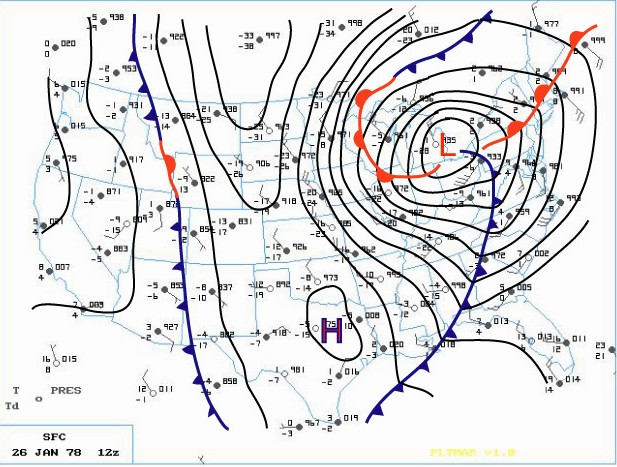 Blizzard Warnings were hoisted across much of the Great Lakes and Upper Ohio Valley Region by daybreak on the 26th as the huge storm (surface | 500mb) continued to track north into southwest Ontario with Sarnia ON reporting the lowest pressure on land at 28.21 inches (955 millibars). Blizzard Warnings were hoisted across much of the Great Lakes and Upper Ohio Valley Region by daybreak on the 26th as the huge storm (surface | 500mb) continued to track north into southwest Ontario with Sarnia ON reporting the lowest pressure on land at 28.21 inches (955 millibars).
The Aftermath
The Great Blizzard of January 26-27th, 1978 came about in a winter known for cold and storms. The Winter of 1977-78 had been one the coldest on record across the central and eastern United States as arctic airmasses periodically spilled southeastward out of Canada and met up with warm moist air from the deep south. This particular winter was especially fierce across the lower Great Lakes with the coldest and snowiest winter on record (since 1893) at South Bend with an average winter (DJF) temperature of 19.7° and snowfall total of 136.3". This was preceded by the snowiest autumn (SON) on record with 30.6" recorded. January was the worst month overall with an amazing month snowfall of 86.1" and observed snowdepth of 41" on January 30th. Fort Wayne faired little better with an average winter (DJF) temperature of 17.8° and snowfall total of 60.6 inches with 25.3 inches coming in the month of January. In addition both stations set their all-time recorded minimum pressures on January 26th with South Bend reporting 28.82 inches (976 millibars) and Fort Wayne down to 28.78 inches (975 millibars).
Eyewitness accounts
Cathy Benko, Starke County, Indiana
How well I remember! Seems like it was yesterday. I was working for my dad in a small country grocery store, located on Highway 8 between Highway 23 and Highway 17. It was about 4:00 pm, the Knox radio station had announced blizzard warnings. I was getting panicky. I had gotten my brother to go check my bottled gas tank to make sure I had plenty of gas for heat. My dad had told me not to fret, that it was not going to do anything. Well it went through 1 ear and out the other. When it was time to close the store, I gathered up a few groceries, milk, eggs, bread, etc., for I had 3 young sons depending on just me. When I got home with the boys and the groceries, I decided I had better let our young dog in, not knowing for sure what was going to happen. Needless to say, the next morning I was very grateful that I listened to my intuitions.
I looked out the window and could not even see the dog house, it was buried, along with my car under the snow. The wind was terrible, after 2 days of it I had cabin fever.
Finally the sun was out and the wind had died down, 2 days later. I had the neighbor girl come over to stay with the boys and I was going to walk to my dad's, as his business was not that far down the highway. I don't know how I walked as the snow was way above my waist, but I did it. It seemed so quiet that day, no automobiles on the road and it seemed like my dad was 2 miles down the road, but was actually only 6 places down from me -- .not even a 1/4 of a mile.
Dad was really busy that day, and did quite well. People walked, pulling sleds, riding horses, snowmobiles, just to get groceries. All the roads were closed. Later on that day, Don Hinds, former owner of a landfill. located on Highway 17, made it to his business to get a pay loader. He made one lane down highway 8. The Borden's milk delivery truck followed Don to the store. So, the store was supplied with milk, but, believe it or not, 2 hours later we were sold out.
1978 was a bizarre year for weather. In the spring when all the snow melted, the Yellow River overflowed it's banks. So much snow, with no place to go. I was right there taking pictures of the blizzard and the flood, and I felt at that I was living through history and that the younger generation would never believe me. A few years back, there were snow storm warnings issued with blizzard-like conditions. My 19 year old, then 15 or 16 , just could not get over that [storm], but I told him that was nothing compared to the blizzard of '78, that was a nasty storm.
Below are several pictures that Cathy took after the blizzard, and one photograph of the resulting spring flooding along the Yellow River. --NWS
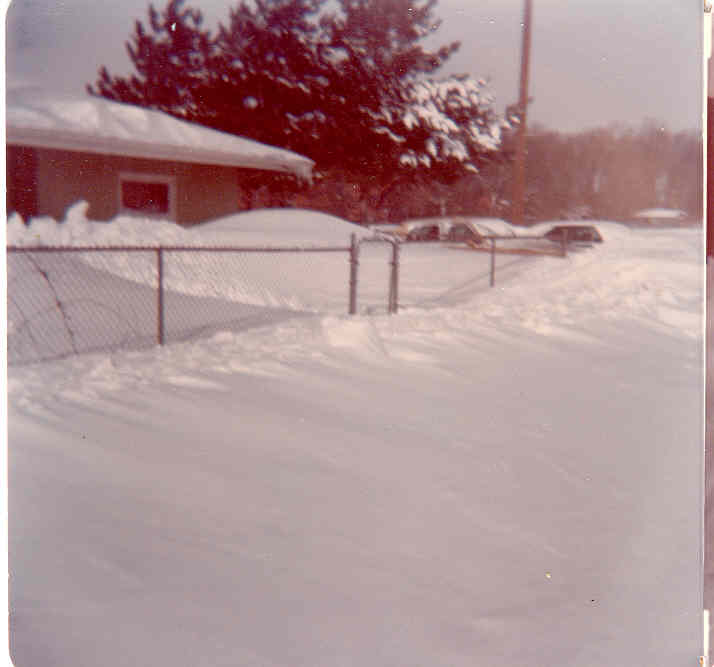 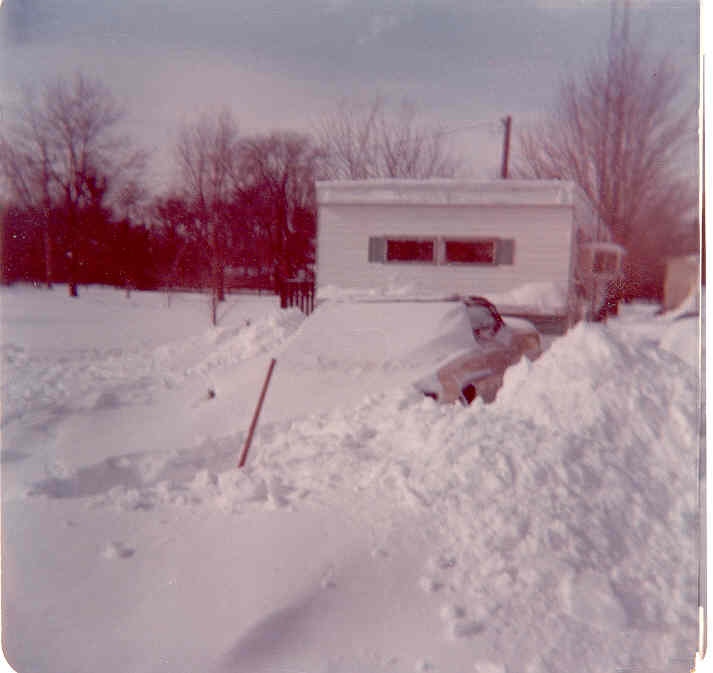 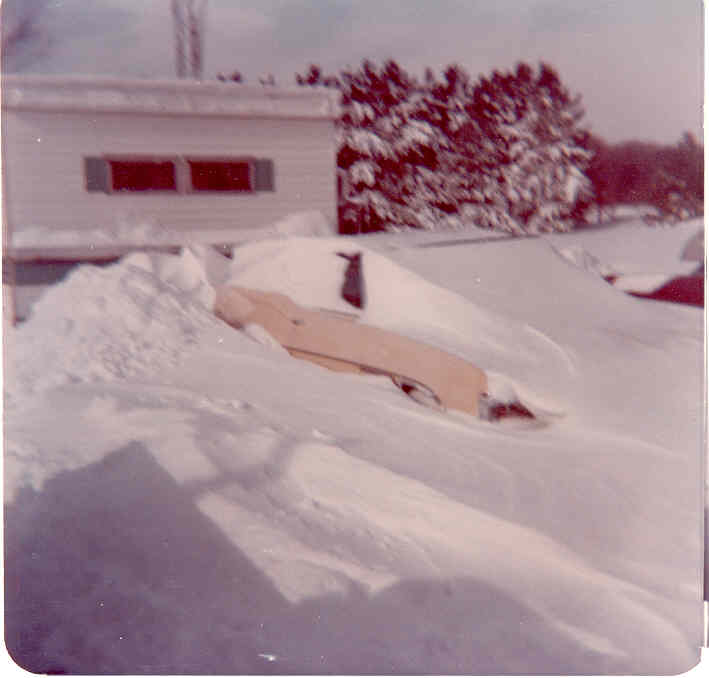 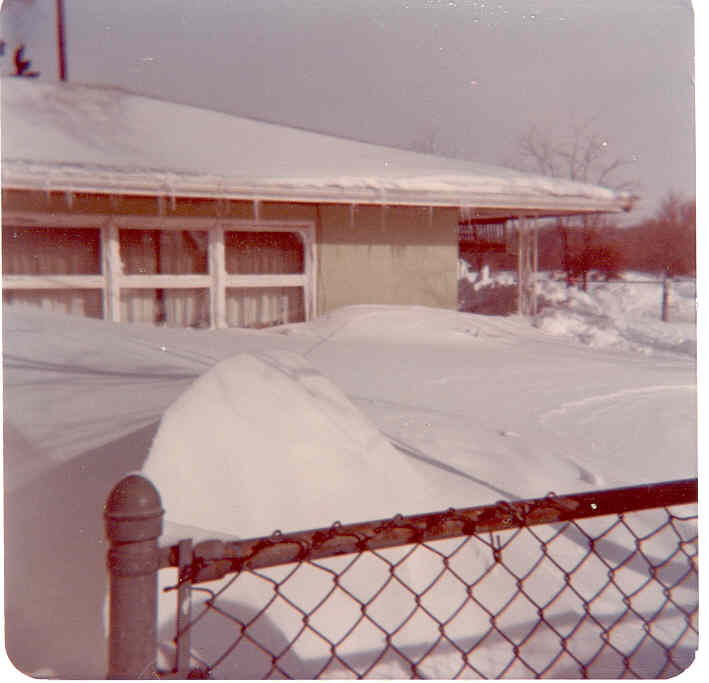 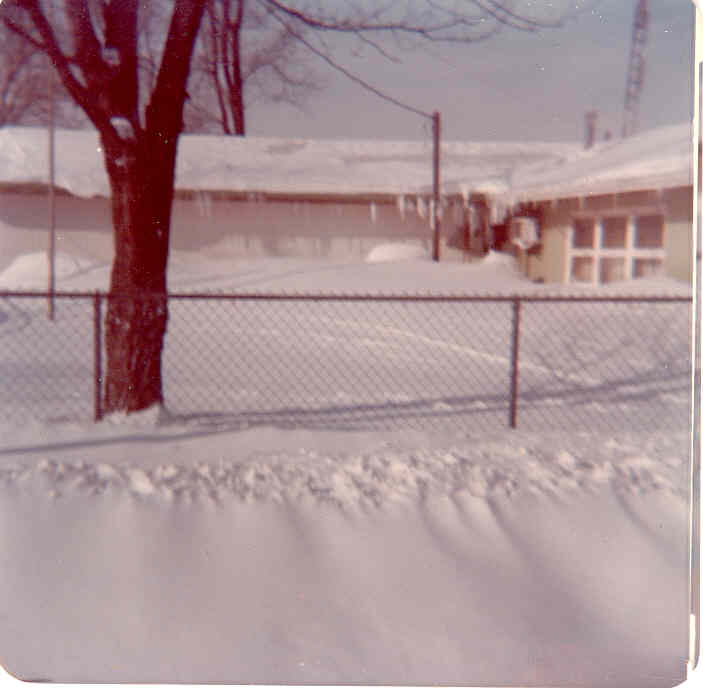 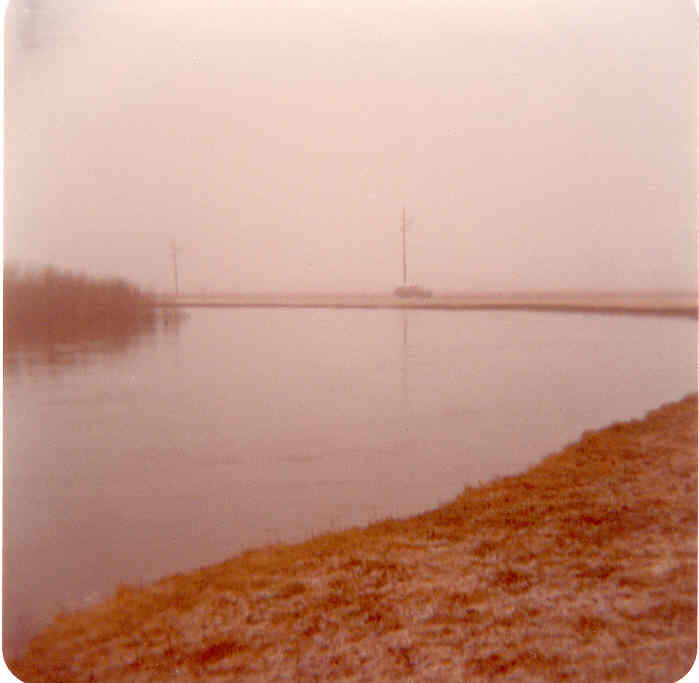
Peter W., formerly of Mishawaka, Indiana
We lived on New Road down from the place where the snow plows were parked. We were fairly poor being an ex GI and the two of us in college with two kids. We lost power during the storm. There were corn fields all around us. We only had one neighbor but they had a fire place. We cooked what little food we had in an open hearth. Just going back and forth between the houses was treacherous.
The snow was so deep in the backyard that the dog could walk around and look into the house by standing on the drifts. The same wind that piled the snow up in 8 foot drifts in the backyard exposed grass in the front yard.
Oddly enough, I moved to Chicago the following year and danged if they didn't get hit with the Blizzard of '79.
Below is a picture of this resident's 1972 Maverick, after the big storm. --NWS
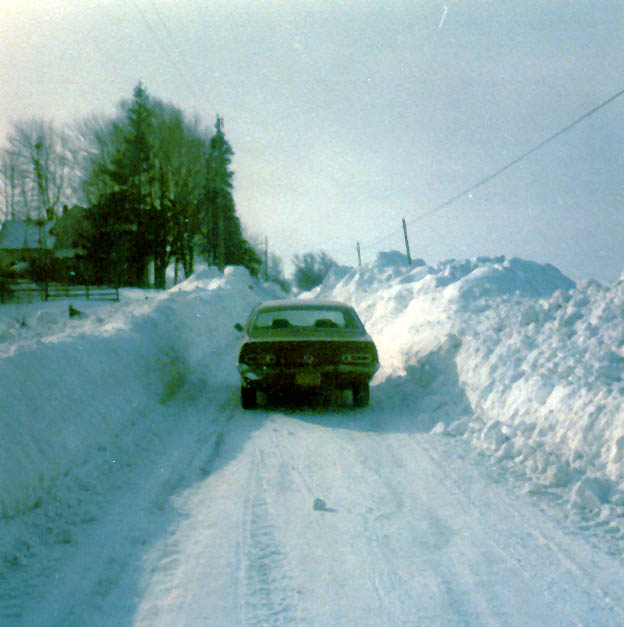
Rex B., formerly of Toledo, Ohio
That Wednesday morning they posted a heavy snow warning with temps around 32. Air was very heavy and still out. About 2" fell and that was it. Later they posted the blizzard warning. That evening the precipitation started as rain and freezing rain. It did that until about midnight when it switched to snow. Huge snow flakes, biggest I had ever seen. That evening the news from Fort Wayne reported heavy snow at 2'' an hour.
On Thursday it snowed hard and blew as was the case all over the Midwest. I was amazed to see a city the size of Toledo brought to it's knees. There was an inch of ice under the snow. You would look up and down normally busy streets and see nothing.
It was 3 days before anyone could travel on the main roads. Five lane roads only had three open. I went to DeKalb County Indiana two weeks after the storm, could not believe the amount of snow and the size of the drifts. Great storm!
Rich Varda, of Osceola, Indiana
We were living in River Park, 33rd Street, which is part of South Bend. I was 14 . What I remember most is all the neighbors helping each other out. My Dad had called the city to find out how long before we were going to see a snow plow, "not any time soon" we were told ! So all the neighbors went out and we shoveled our street clean ourselves digging all of the cars out in the process. We would also find out who needed what from the grocery store and walk with sleds in tow down to Benner's market at the corner of 30th & Mishawaka Avenue. When Benner's was cleaned out then we had to walk up to the old Martin's by Town & Country Shopping Center -- that was about a 2 mile walk.
The site of Army Reserve Personnel carriers and trucks driving down Mishawaka Avenue is vivid memory as well. Cars so buried under snow you weren't sure if a car was there or not. As my pictures show, all the neighbors really pitched in together. The picture of the boy in the tree is me, the depth of the snow was about 10 to 12 feet from shoveling out all the cars and I was able to walk right in to this tree!
Click on the pictures below for larger versions. --NWS
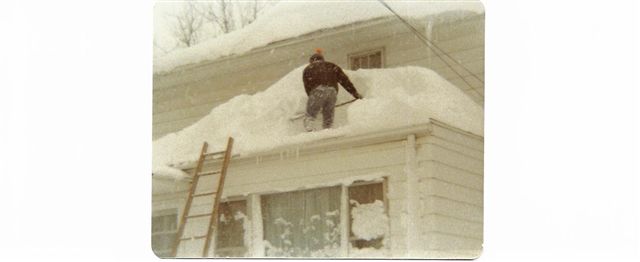 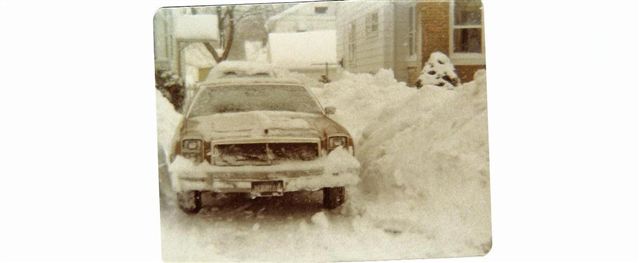 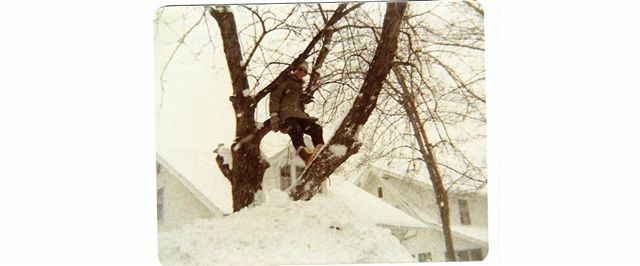 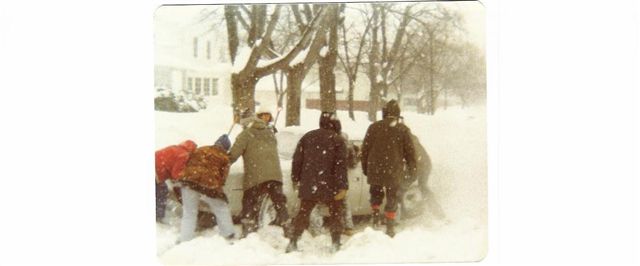 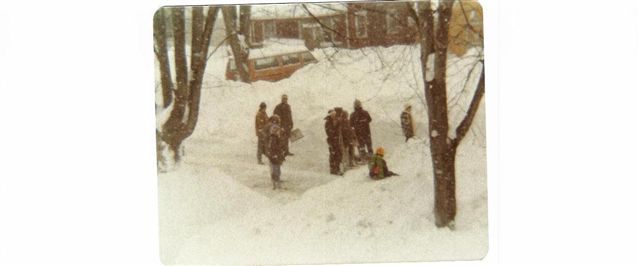 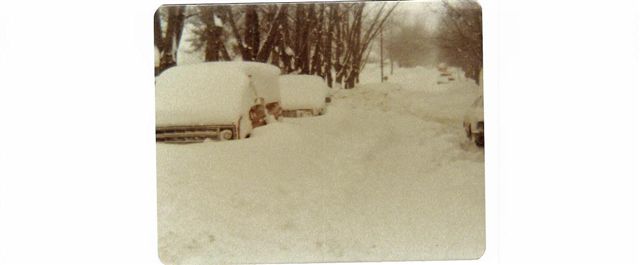 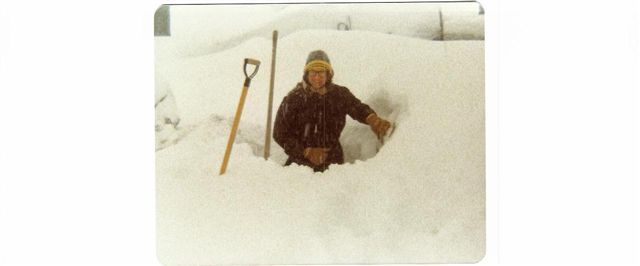 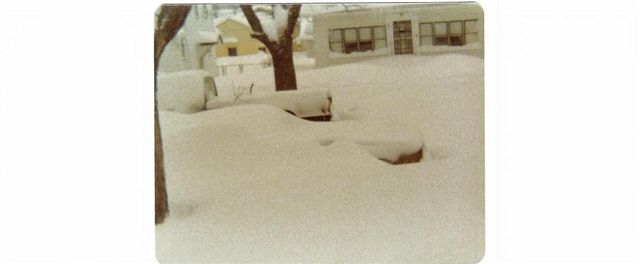 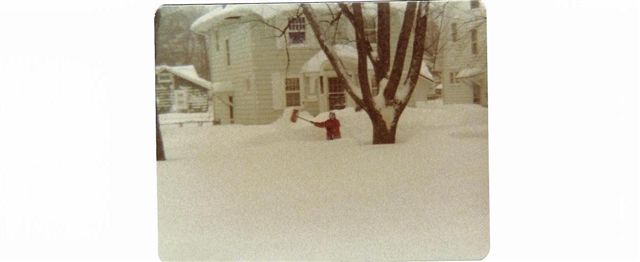
Dennis F., of New Haven, Indiana
Boy, this blizzard sure brought back memories. In January 1978 I was an EMT (Emergency Medical Technician) for the Woodburn Fire Department. In fact, I was one of the few that was trained as an EMT around home. Sometime during the height of the blizzard I received a phone call from the Fire Department stating that they needed my assistance, a priority one response, via snowmobile (Yamaha 250). It seems that a report came in that a woman and children were stranded somewhere south of Woodburn between Highway 101 and what was then Highway 14 (now Dawkins Road) in the blizzard. So, with my handheld CB radio I put my snowmobile suit and helmet on and proceeded near US 24 north of Woodburn and then south on Bull Rapids Road. Of course, even by snowmobile conditions were terrible with blowing and drifting snow, 5 to 7 foot drifts, and whiteout conditions. Just horrible.
Anyway, I took off, in fact, now knowing where I was going, due to the whiteout conditions. I wasn't too far from US 24 and Bull Rapids Road when, suddenly, I hit a whiteout. It was so bad I couldn't see anything at all -- let alone the road! So I ended up in a ditch probably 5 to 10 feet deep. Fortunately the drifts in the ditch broke the fall. I was disoriented and somewhat shook up. I lifted my leg to get off the seat of the snowmobile and my helmet hit something hard. I couldn't see because of the blowing snow, so I took off my helmet to see, and my hand felt something hard and rigid. After looking up close real hard, I then realized that I cam within a foot or two of hitting a telephone pole head-on with the snowmobile!! In other words, I came real close that afternoon to meeting the good Lord. I got out my CB. I had a base where my parents was monitoring and radioed to my folks that I needed help. My snowmobile sank two or three feet into the snow drift, and I couldn't get it out by myself. Soon my father, sister, and brother walked a third of a mile or so in the blizzard. We finally got the snowmobile home. Fortunately, I wasn't hurt, but I was sure shook up pretty good.
Needles to say, I couldn't make it to Woodburn, which was two miles south of my location. To this day I don't know if there was a woman and her children trapped in the blizzard, but, I assumed they somehow had gotten out all right, or received other help.
When the call first came in, I was leery about going out, but, at the very least I had to try, despite the extreme adverse weather conditions. I can still remember the January 1978 blizzard, and the events during and after the blizzard. The Blizzard of '78, a date and time to remember, for the rest of my life.
Beverly R., formerly of Allen County, Indiana
I tell my daughter (who is 10) about this blizzard and she looks at me like I am insane!! She says there in NO WAY snow drifts covered our 2nd story windows. On the last trip to Grandma's, I showed her those pictures -- she was amazed. We lived on Bethel Road, right across the road from the "old" Carroll High School. Our house faced west and that is were the wind was coming from, right across the empty corn fields. I was a freshman in college and I remember going to bed the night before and the news saying snow. Both my Mother and Father tried to get out of the garage to go to work the next morning. They gave up after 2 1/2 hours of continuous shoveling. After 2 days of being stuck in the house, the winds finally died down enough for us to attempt to dig out. All the neighbors came out to help each other. We all got our driveways cleared but the snow plows didn't come to the main road for almost 2 weeks. The local University were I attended was shut down for about 2 weeks also -- which is unheard of. If it wasn't for our neighbors pitching in their snowmobiles, we would not had milk, bread or toilet paper!! After the plows finally dug out a one lane path on the main road, it looked like and felt like you were driving through a tunnel. If I remember correctly, we still had snow piles around until April of that year. I know I will never see snow like that again (nor do I want to) since I now live in the South.
Larry Mayer, Plymouth, Indiana
Way back in 1978, in late January, I was living on the south side of town, in Milford, Indiana. I was a mobile home electrician for Fairmont Homes in Nappanee, Indiana. The day before the big blizzard would hit us, the local weather reports were of impending doom and many snow totals were so far fetched, many people did not believe such a snow event would happen of that magnitude. I was 24 years old at that time, and very strong as I was a body builder as a hobby. I was married to my ex wife Karen at that time, and had a son living at home who was 4 years old.
On the morning of the approaching storm, I noticed as I got into my truck, the wind was very calm, and the air felt funny. It had a damp feel to it. They say in Indiana, the sky is always clear before a big storm and on the day of the blizzard it was clear as it could be. Around 2:00 on that day, our boss came up to us and told us to get home. The State police said it was snowing so hard in Illinois, that you could not see across the hoods of their squad cars. We all left, laughing and making jokes of the snow storm. When I got to Indiana 6 and 15 to head south, I looked to the west and saw a terrifying sight. The clouds in the distance were black as coal and it looked like a wall coming at us. I knew right there and then, the storm predictions were possibly going to be correct. My ( ex wife) was already at work in Goshen, as she was working second shift. I turned the truck around and went up to Goshen to get her. When I got to Goshen, the snow was starting, and it was putting it down. I got the boss to let her out, and they decided to let em all out. Karen followed me in her Monte Carlo and she said all she could see was the tail lights of my truck all the way to Milford. I had a 66 Ford with cab over lights that helped me see better than most.
The evening came, and so did the wind. But the wind did not pick up harder until about 10:00 that night. I went down the street at 7pm to play cards with some buddies. By 8 :00 we looked out the window and it was snowing so hard, you could barely see the street light. I went home. It took me 20 minutes to make it 2 blocks and my ex was pretty mad. Once inside, the snow started to come so hard, you literally could not see anything but snow. I for one being a young man, at 24 was pretty concerned. As the night went on, the wind picked up and many times the wind blew so hard, it broke the roof edge railings and the hinges were the only thing keeping the roof on. We thought for sure the roof was going to fly off.
Morning, the day after the great blizzard. I got up and looked out the window, and I was sure somebody had stolen my wife's car. Then, the reality kicked in, that the snow was over her roof top. I ran to the front door, which had a storm door with a huge full glass window. When I opened the door, I was shocked to see snow half way up the door. ( it snowed 47 inches over night) I yelled for everybody to come look and they too were puzzled and in awe. I turned on the TV. The local news was all about the blizzard, and the entire tri-state area was under a state of emergency.
On day 3, Many of our neighbors who had ignored storm warnings were out of critical goods, like baby formula and milk and bread. So, I got the sled out, and rounded up some other guys. 3 of us trudged to the north end of town. A mile and half walk. It took us 2 hours to get there. We loaded up the sled as best possible and went back, delivering what people needed, but the store was pretty well picked over when we got there. We were lucky to get what we did. I was in the shape of my life and that trek in the snow wore me out so bad, I was totally exhausted.
The real drama hit us on day 4. A semi driver was stranded on Hy 15 on a bridge by Purina Chows and he had run out of fuel and any way to eat. I was able to get a snow mobile from my neighbor. He and I ( Dave Elliot) made our way through heavy high snow and got to the truck driver. We got him back home and Dave let him recover in his house, which was right across the street from us.
To this day I hope I never see a snow storm as bad as that one was, it tragically killed some people, as many were stranded in their cars and so on, and ran out of fuel. As many days went by, the sound of helicopters were all you would hear, and it was 12 days until the pay loaders got the main roads opened up to be able to drive on. From that day on, I have never ignored a snow storm watch or warning.
Bill Helberg, New Bavaria, Ohio
I remember on the evening of the 25th, during the warm air and rain, discussing the weather warnings coming from Earl Finkle on good old WOWO radio. We all that had to be impossible. Upon waking up to go to work, we found out just how right they were. White out blizzard and nothing moving. The rest of that day we just stayed in and didn’t do anything.
By Friday those of us that were volunteer firemen and lived in town decided to man the firehouse for any emergencies and to be in radio contact with the county. That night late, a call came in for a rural lady who went into labor. Being a township trustee, I called our snowplow operator to see if he could get to the house. He was able to get the v-plow to her and transported her to the county line and state route where an ambulance met him and took her the rest of the way to the hospital. Two of our rural firemen who could not make it to the firehouse, got a call from their neighbor who also went into labor, and by snowmobile got to her and actually delivered the baby. Later, we all joked, it must have been the record low pressure system.
By Sunday we were able to start working on our township roads. We had two plows and two payloaders and stayed busy with them for the next five days until we were mostly passable. In a couple of spots drifts were over the telephone poles and wires. Those took longer. At the time I lived in a two-story house with an upper back porch and doorway. Snow was drifted up to it and that was my access in and out of the house.
|
Please share your pictures, stories, and memories of the event with us and with all who use this website. Send your contributions to us via e-mail, or via regular postal mail to:
National Weather Service
c/o Climate Focal Point
7506 East 850 North
Syracuse, Indiana 46567
When sending photos, please let us know if we may post them to the website, and how we should credit them. If sending photos via regular mail, we will not be able to return them with out a self-addressed stamped envelope.
|
|
